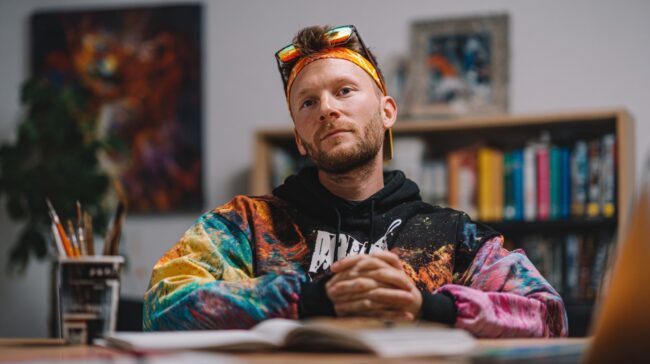Artist branding plays a critical role in gaining recognition and loyalty in today’s saturated creative space. A memorable image helps artists rise above the noise. Creating a compelling presence doesn’t require complexity. With intention and consistency, artists can shape how they’re perceived while remaining authentic.
1. Define Your Artistic Identity

Artistic identity shapes everything an artist puts into the world. Before gaining recognition, an artist must take inventory of personal style, repeating motifs, medium of choice, and the emotional pulse behind every creation.
That identity should not be an afterthought; it must guide every decision made across platforms, visuals, and communications. A clearly defined voice allows an artist to become memorable. People naturally gravitate toward what feels honest and consistent. Messaging that feels generic or scattered makes it harder to attract and retain interest.
Specificity invites people in, lets them connect emotionally, and keeps them engaged. To build a meaningful connection, every artist needs to make intentional decisions about core elements. Clarify the direction by identifying:
- Focus on the ideas that frequently show up in the work, like nature, conflict, solitude, identity, etc.
- Decide what form best expresses the message: oil painting, digital illustration, sculpture, mixed media, or even hand-painted backdrops.
- Consider techniques, brushwork, composition, and influences, minimalism, expressionism, realism, or abstraction.
- Define the emotional undercurrent. Is the work introspective, loud, soothing, aggressive, or ironic?
Consistency builds trust. When an artist delivers on what they promise visually and emotionally, collectors, curators, and audiences feel comfortable engaging with the work and recommending it.
2. Create a Cohesive Visual Presentation

Audiences absorb meaning through design choices before reading a single word. When everything an artist shares follows the same look and feel, it builds recognition and credibility. A scattered presentation confuses people. One day the visuals are muted and moody, the next they’re saturated and loud. That inconsistency sends mixed signals.
A solid visual identity gives work a face and helps audiences identify it instantly in a crowded feed. To make the visual branding cohesive, ensure alignment across all major outlets. Artists should intentionally shape their brand’s aesthetic through the following:
- Pick 2-4 core colors and use them across your website, posts, packaging, and promotional materials.
- Stick to one or two fonts that reflect your tone, handwritten, bold, modern, serif, etc.
- Create a visual signature using your name or symbol and apply it to all professional platforms.
- Present work in a consistent setting. Use clean backdrops, natural lighting, or editorial styling.
- Choose image treatments that reflect the brand’s energy, dark and dramatic, clean and minimal, vibrant and lively.
Social platforms, websites, newsletters, and business cards should all reflect the same tone. If someone visits your Instagram and then clicks to your portfolio, nothing should feel like a surprise.
3. Develop a Strong Online Presence

Visibility builds momentum. Without a strong online presence, even exceptional art risks going unnoticed. In today’s creative space, showing up online is a necessity, not an afterthought. A professional website acts as the anchor for your digital presence.
It’s where people go to learn more, see work in high resolution, and make contact. Social platforms help build relationships, but a dedicated site gives full control. At minimum, the website should include:
- About page: Brief background, artist bio, and insight into your purpose.
- Gallery or portfolio: High-quality images of work, categorized and clearly labeled.
- Contact page: Easy way for visitors to reach out for commissions, collaborations, or purchases.
Social media expands reach and invites interaction. Instagram works well for visual artists. Facebook can be effective for community-building and event promotion. TikTok may suit those who want to share process and behind-the-scenes footage.
No matter which platforms are chosen, activity must be consistent. A dormant feed discourages engagement, while regular posting keeps your name fresh in the mind of your audience.
4. Craft a Memorable Artist Bio and Statement

Words matter. A compelling artist bio and statement offer more than background, they provide context, clarity, and connection. Viewers want to know who’s behind the work and what drives the creative process. Done well, these written pieces become tools for resonance and recognition.
A concise bio doesn’t need to cover every event in an artist’s life. It should focus on relevant experiences and influences that shaped the work. Think of it as a highlight reel that brings out personality and purpose. Strong bios often include:
- Origin of your artistic interest
- Training or experience that refined your practice
- Key moments, exhibitions, or turning points
- What themes or questions guide your work
Tone matters just as much as content. A bio written in a personal, confident voice will stick in the reader’s memory. Avoid exaggerations or empty buzzwords. Sincerity has more weight than polish. An artist statement should explain what the work is trying to say and how it says it. It speaks not to critics or scholars, but to everyday people seeking meaning in your work. Clear, direct language will always outshine academic fluff.
5. Be Consistent with Communication and Content

Consistency builds identity. Sporadic posts, shifting tones, or conflicting messages leave audiences guessing. A strong brand thrives on rhythm, repetition, and familiarity. Captions, email newsletters, interviews, and comments all shape public perception. That voice should reflect the same energy, emotion, and style as the work itself.
Every point of contact becomes an opportunity to reinforce identity. Someone opening a newsletter, scrolling past a reel, or reading a post caption should feel like they’re experiencing a continuation of the same voice. Shifts in tone confuse people.
If one caption is poetic and the next is sarcastic, or if one email sounds formal and the next sounds rushed, the brand loses shape. Even when experimenting with content formats, videos, carousels, reels, livestreams, the message should still align with the artist’s values and mood.
A minimalist painter shouldn’t suddenly adopt chaotic edits with loud music unless it’s intentional and rooted in the brand. Creating templates or content calendars can help manage consistency without draining creative energy. Planning posts, batch-producing visuals, or creating a content rhythm for the week can reduce stress while maintaining structure.
6. Engage with the Art Community
View this post on Instagram
Artists do not grow in a vacuum. Isolation limits exposure, creativity, and opportunity. Real growth often happens through exchange, sharing work, supporting peers, receiving feedback, and contributing to collective momentum.
Participation in the broader art community elevates visibility and reinforces credibility. Showing up, both physically and digitally, signals that the artist is serious about the craft. Artists can strengthen their presence by engaging through:
- Apply to group shows, submit to juried competitions, or participate in local pop-ups. Exposure to diverse audiences opens doors to new conversations and collaborators.
- Hosting an open studio invites visitors into the creative process. It offers transparency and makes the work feel more personal.
- Platforms like Discord, Facebook groups, and artist collectives offer networking and inspiration without geographic limitations.
- Teaching or learning within the community builds visibility and skill while forging connections with other creatives.
- Engaging with the work of fellow artists online, liking, commenting, and reposting, creates reciprocity and builds goodwill.
Meaningful collaboration can take many forms: joint exhibitions, zines, mural projects, or co-hosted workshops. These projects not only expand reach but add depth to your creative practice.
The Bottom Line
Strong artist branding isn’t about flashy tactics or marketing jargon. It’s about staying clear, authentic, and consistent over time. By defining identity, presenting work thoughtfully, engaging with others, and staying present online, artists can grow a brand that reflects their purpose and draws in the right audience. Creative courage, honest storytelling, and commitment to showing up, those are the tools needed to build a powerful artistic image.
